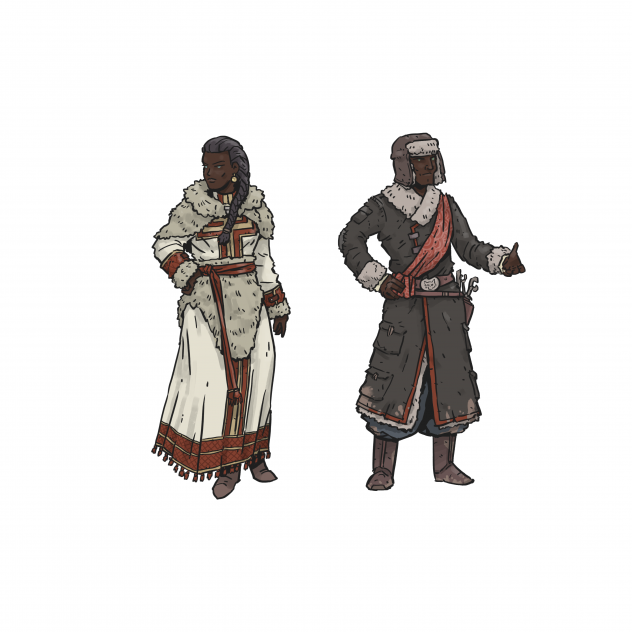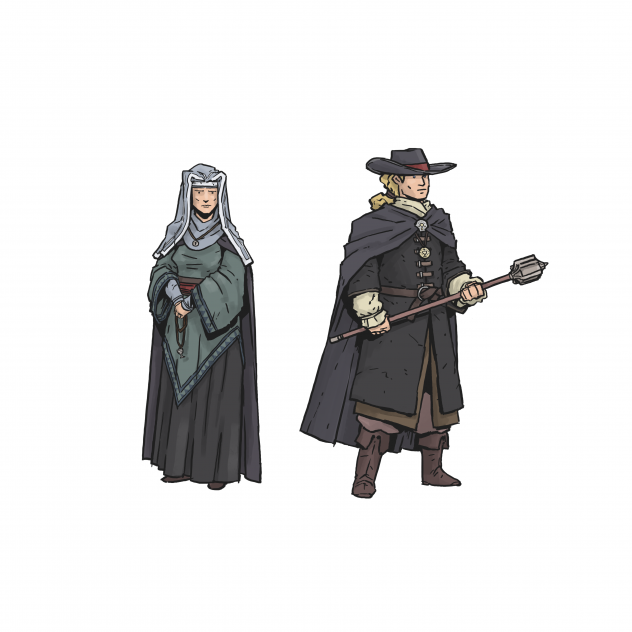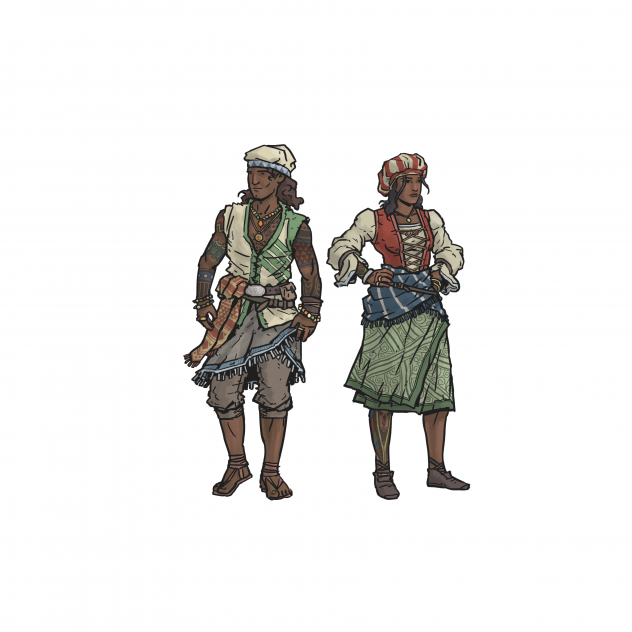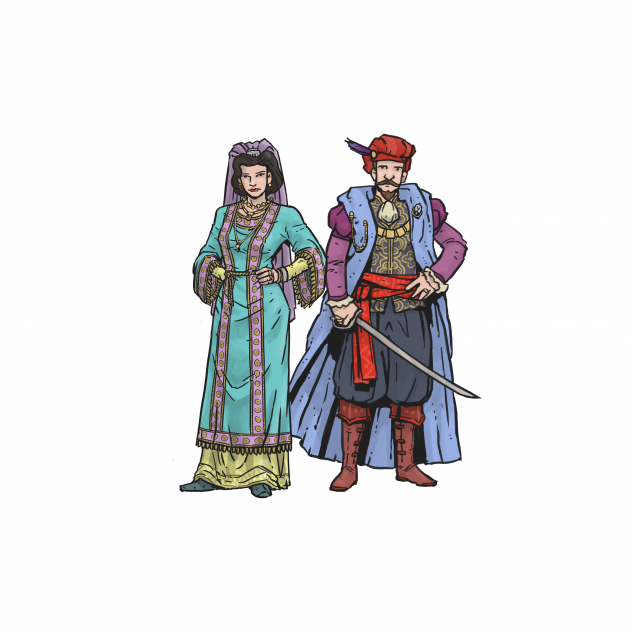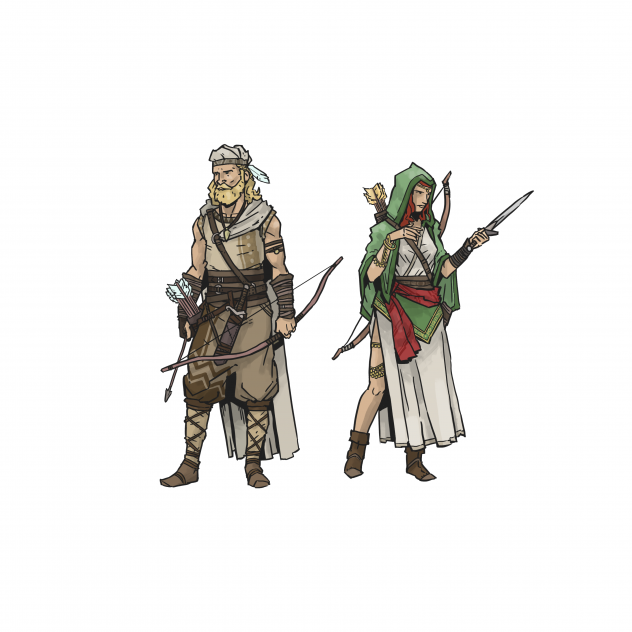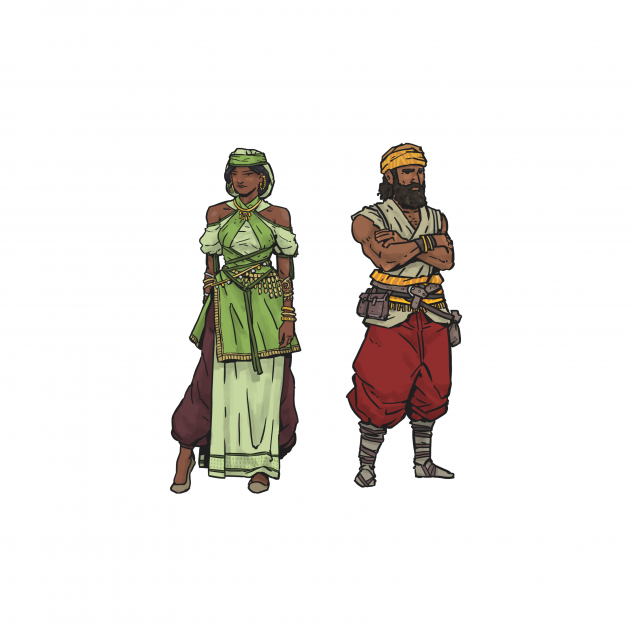HILLFOLK
The Hillfolk historically hail from the hills and mountains throughout the realms, though today most reside in the Tarn Mountains near the cursed Orkin Woods. They are clannish in nature and generally stick to their own societies, and are particularly known for their ferocity in battle, and for their lack of fear even in the face of insurmountable odds.
While they may be intelligent, few know or care about the intricacies of politics or city life. They would have little to no formal education and
would likely be unable to read or write.
Most Hillfolk have swarthy or olive complexions, are dark-haired, dark-eyed, and tend toward the shorter, stockier side. Both men and women wear their hair long and keep it neat in braids; men tend to grow long beards and braid them, too.
Lithmorrans generally regard them as hairy forest brutes in desperate need of civilization, who wear bear pelts, smoke floleaf every day, decorate their homes with skulls, and killed and ate each other before the Church (thankfully) stepped in.
One perhaps less-offensive typical perception is of Hillish stubbornness: a Lithmorran might think of a Hillman as someone they could ride out into the middle of the woods, drop off, and six months later there would be a cabin and vegetable patch in the exact same spot.
Note: Among the Hillmen, clan chiefs and their families are nobility, though in the eyes of Lithmorrans, such men and women are merely freemen. In Lithmore, Hillmen may never rise above the status of freemen, even if they share the blood of another race. They also may not lead any legal guild.
Average Statistics:
Female: Height 1.52m (5’0″ ft), Weight 51 kg (113 lbs)
Male: Height 1.57m (5’2″ ft) , Weight 59 kg (131 lbs)
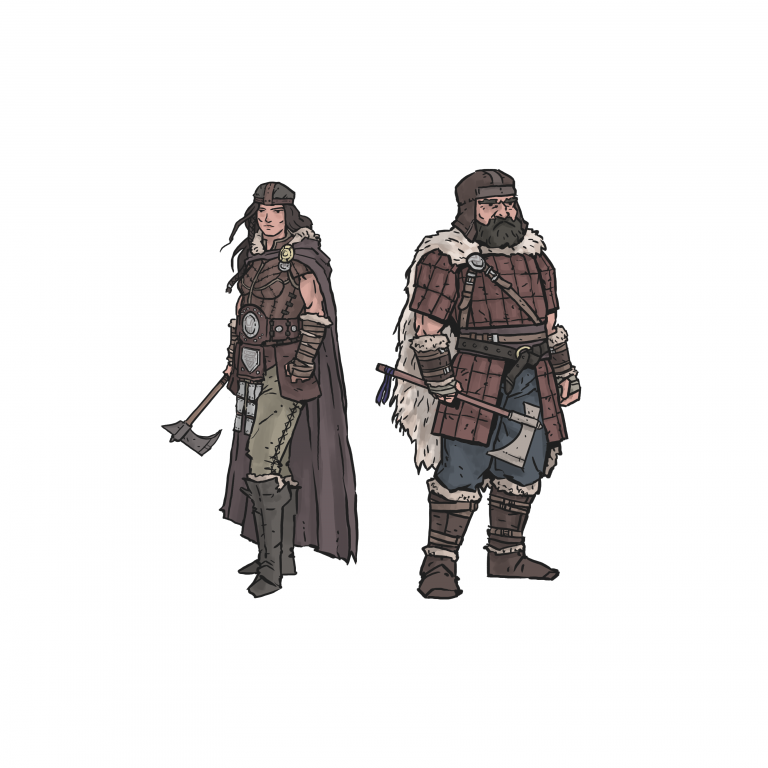
FAITH
Though the Tarnlands have no formal province and almost no established churches, there is a strong influence of Hillish clan faith in Davism: the springs where Dav found enlightenment are in the Tarn Mountains, where Hillfolk worshipped the Giver of Water above the general Lithmorran Mother Church pantheon as they sought to ascend to the Riverlands after death.
It is because of this mixing with local mythology and oral tradition that the Hillish sect of the Order is easily the least rigidly adherent to the Order’s traditions and the words of the Erra Pater, however, its adherents are easily the most devout of any region in the Kingdom. Clan elders are often recruited into the Davite priesthood given their experience in dealing with common customs of local Hillfolk.
Song-stories passed down are often adapted to fit the Davite canon as necessary to avoid speaking or teaching heresies; stories often involve creation myths, cautionary tales, and important teachings. Hunters, warriors, and anthropomorphic prey animals are frequent subjects. While some clans interpret the mythos more literally, many see them as metaphors for crucial survival lessons.
Saints are almost entirely ignored in Hill culture (where warriors and heroes are more commonly venerated) and living so near to the Orkin woods, “demon” is synonymous with the commonplace horrors lurking about the edges of many clan territories. While urban Davites generally pity the magically-tainted and view pyre-cleansing as an act necessary to save a soul, Hillish morality and experience frames magic as something to be feared and despised, something that must be eradicated to protect the clan.
Overall, the Holy Order generally sees the Hillman race as something of a throwaway, and except when they wish to test a new acolyte or put a troublesome priest out of the way, the Hillfolk are mainly left to minister to their own spiritual needs.
FASHION
Hillish fashion is grounded in practicality, and much of their aesthetic comes from their tradition of war. Pelts of formidable animals are valued status symbols; talented warriors and skilled hunters are venerated in Hillish society. Claws and teeth as embellishment can serve this purpose as well while also ensuring even the less functional parts of animals do not go to waste.
Silhouettes tend to be bulky about the shoulders and serve to intimidate. Well-fitting boots and fingerless hand wraps are particularly important for clans settled near steeper ridges and cliffs, for whom the ability to climb is a necessity.
Staples of a Hillish wardrobe include wool tunics and pinafores, both soft and hardened leathers for protection, and bulky fur capes, boots, and hats for warmth. Hillmen typically don’t compartmentalize clothes beyond what is most practical or comfortable in any context; if a Hillman were invited to a Vavardi garden party, they might well show up in the same furs and leathers they wear out hunting, though they are also known to employ face paint and braid ribbons into their hair in preparation for both battles and celebrations.
When jewellery is worn, it is typically carved beads, whether from wood, bone, horn, or claws, though excess minerals may be smelted into charms and pendants. When dyes are used for embellishment, they are produced from local plant matter and minerals – location naturally dictates favoured clan colours. Sap-based and dyed lacquers are often used to polish up decorations, both for clanspeople and more often for trade.
Because Hillish homemakers are solely responsible for all household duties and chores, one iconic feature of the Hillish wardrobe is a decorated belt or necklace from which they hang most often-used tools, such as small knives, cases for pins and needles, or sewing shears.
TRADE
The bulk of Hill trade products are in the variety of raw resources they have unique access to in the mountains, including wool from the sheep they raise and handmade crafts such as pottery, beads, and simple metalwork. Furs are plentiful, and eagerly desired elsewhere, allowing a hunter to make a comfortable living. Sap and resins from certain trees as well as dyes from local plants are also sold, usually for use in the production of cosmetics or lacquer.
Woods are sold either as lumber or in the form of decorative wood carvings of unparalleled beauty; Hillmen are renowned for their woodwork and produce elaborately-carved furniture, jewellery, beads, and ornaments. Despite stereotypes surrounding Hill barbarism and incivility, wealthy members of the Lithmorran gentry are known to collect and proudly display artworks from the hills as conversational pieces.
Being a handy and self-sufficient group of people, Hillfolk are adept at crafting weapons; Hillish bows tend to be powerful, recursive composite of horn, bone, and wood bonded by sap. In the rockier parts of the mountains, iron and mineral deposits are tapped for use by Hillish blacksmiths rather than trade, as the iron ore unclaimed by the Kingdom that they have access to is of rather impure quality. Pewter or white bronze is typically favored for ornamental works.
While their method of outdoor smithing is considered crude amongst other races, the number of times a family’s heirloom weapon (usually a battleaxe) is reforged to include the ashes of each deceased wielder will eventually temper and purify a weapon over the generations; weapons forged on funeral pyres will adopt a wavy, organic patterning and a peculiar bluish cast that graduates to a copper tone at the cutting edges. Trade in weapons has steadily declined since the cessation of active warfare with the Daravi.
FOOD
Hillfolk eat what can be procured with next to no imported foods or spices such as cinnamon or nutmeg in use. Garden plots and small fields bear hardier plants, though whats forageable also dictates a Hillmans diet, especially higher in the mountains.
Food is generally eaten with one’s hands, drunk from bowls, or scooped up with flatbreads (particularly in the case of hearty soups and stews). Root-based beers, ales, and meads are the preferred beverages to accompany meals. Without access to salt, food is either dried, smoked, cooked into syrup (fruits), frozen outdoors through the winter, or packed in jars to ferment.
Game meats, eggs, and goat milk and cheese are the most likely proteins to be eaten, though a goat, chicken, or sheep that can no longer produce milk, eggs, or wool will not be wasted. In many clans, different types of wild grains have been domesticated over generations. Potato flour and animal fat is used to make fried flatbreads, and buckwheat and barley are used in breads and extremely heavy rolls.
Roots, squash, and melons keep Hillish clans fed year-round, and small herb gardens will often contain at least cardamom and bear garlic – their utilitarian nature predisposes them to the heavy, dense, and filling, but Hillish food is also quite rich and flavorful. Hillmen particularly look forward to winter game and vegetable stews.
CUSTOMS
Naming: A Hillman name consists of three elements: the name given by the father and mother, jointly, to the child; a name given by the father; and a name given by the mother. Following these names is the typical suffix, “of Clan X.” Many adopt Davite names given by missionaries for reasons of faith or simply to fit in better if they visit the city. The bowmaker Aslaug Syn Edda of Clan Hoenir may choose to simply go by Aslaug Hoenir, or properly Lithmorranize as Alison Bowyer.
Ancestor Weapons: When a clan member dies, they are typically cremated on large pyres laid to create as large a pillar of smoke as possible in hopes it will elevate the deceased’s soul to the aether, or more recently, to the Fountis. If the deceased Hillman was a particularly great warrior, their ashes are reforged into their own weapon and passed down to their first heir. The weapon a Hillman carries may have been reforged many times as many generations of predecessors were smelted into it.
Song-stories: As Hillmen have a strong oral tradition, Clan histories and records of events are passed on as song-stories: epic, sung sagas. While Hillmen are often viewed as an inarticulate and awkward people, Hillish song-stories are complex and poetic, beautiful to listen to.
Fighting: Contributing to the popular brutish Hillman stereotype, Hillmen frequently enjoy good-natured bouts of fighting, whether it’s brawling in the field or ceremonial wrestling in the village square. Hillmen do not consider such fighting to be immoral, and, in fact, trial by combat is considered an honorable method of conflict resolution. Hunting animals: Hillmen are known for their prowess as hunters, and those among them who do hunt will often train large birds of prey to aid them, as birds have an easier time navigating the treacherous ridges of the hills than dogs. Golden eagles are favoured, though smaller-bodied hunters and children may use a few different varieties of hawk to hunt. Hill-bred Tarnlands ponies are notable for their thick, insulating coats and surefooted step on rocky passages.
Body Decoration: Despite the Lithmorran stigma on body modification, it’s fashionable for Hillish men and women to wear multiple piercings of blackened steel, cord, and bone, as well as elaborate tattoos on the upper arms and back.
MORALS
Hillman society is very unforgiving, regimented and unchanging. They fiercely believe that a man in good standing with faith (whether to the Giver of Water or the Davite version, Lord of the Springs), is ascendant; they believe that a man judged morally lacking should make restitution or else suffer eternal damnation.
The Hillish definition of loose morals tends to ignore non-violent bodily sins such as fornication and impurity; however, as Hillmen are so clannish in nature, betrayal is tantamount to crime. The definition of betrayal is far-reaching and includes personal affronts such as lying, stealing, and adultery as well as simply proving unreliable or being lazy and useless.
More serious are those which Hillmen term blood betrayals, which include double-crossing one’s clan, forsaking a prior spouse or children, pledging allegiance to a foreign entity, or marrying a member of another race. Within the city, the notion of blood is often expanded to include all of Hillish origin, as there are relatively few Hillmen, and all share the experience of discrimination.
While the Hillmen espouse a very primitive penal code (preferring to rehabilitate wayward members with words or fists rather than incarcerate them), the clan elder or head will typically weigh crimes and determine punishments for infractions. Hillmen occasionally fight to death in trial by combat, but exile is more typical for the worst of betrayals against the clan; near the Orkin Woods, exile is almost certainly a death sentence. As it is unusual for a Hillman to leave home, those seen in Lithmore are often those exiles or outcasts who survived.
Because of their beliefs and the philosophy that man should aid his neighbor in achieving the glory of the Heavens, violent crimes in the Hills are almost unheard of. In the Hills, a traveler might see relatively harsh penalties given out for relatively minor crimes like lying, blasphemy or quarreling with a neighbor – in urban areas, Hillmen may express shock over accepted casual dishonesty and can be perceived as particularly gullible or rude for their bluntness. Those made aware of the peoples beyond the mountains tend to particularly disdain the Charalin peoples, viewing their selective word use (Charali bending) as underhanded and despicable.
In the mountains, workable farmland is a precious commodity, and historically, clan wars would often erupt over control of even the smallest fertile plots. Despite the brutish Hillman stereotype, for many clans, time has tamed yearly farmland disputes from bloody battles to ceremonial brawling matches. Every year, the clans of a specific area will gather and send champions to battle, to determine who gets the farmlands, thus avoiding the full-on horrendous casualties of before – the declining suspicion and hatred of all other clans has allowed smaller and less warlike clans to trade for food as well.
EDUCATION
Formal education as Lithmorrans understand it, is a practical non-issue amongst the Hillfolk, though they typically have keen minds with a firm grasp on how the world works. Their children learn the necessary life skills from working side by side with their parents: crafts, weapon crafting, cooking, hunting, and the art of warfare. Children are expected to be attentive at all times to their parents and learn from modeling of proper technique.
The only exception present is that the Davite missionaries and few clergy in the few assorted actual churches receive at least a basic education in reading, writing, and Davite philosophy.
